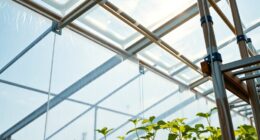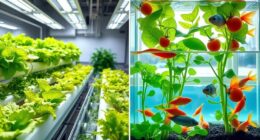To maintain your greenhouse structure, start by inspecting the frame for rust or rot. Check the glazing for cracks and clean it regularly to enhance light. Don't forget to care for gutters and ensure proper drainage. Inspect foundation and support structures for stability. Finally, keep doors and ventilation systems operational. Regular checks every season will help spot issues early. If you'd like to discover more tips for effective maintenance, there's plenty more to explore.
Key Takeaways
- Regularly inspect metal and wooden frames for rust, rot, and structural integrity to ensure stability.
- Maintain glazing materials by cleaning surfaces, repairing cracks, and replacing damaged panels at least biannually.
- Clean gutters and downspouts twice a year, ensuring proper drainage and blockages are addressed.
- Check foundation and support structures for wear, corrosion, and adequate drainage to prevent damage.
- Ensure doors and ventilation systems are well-sealed and operational to promote airflow and prevent pest entry.
Inspecting the Greenhouse Frame
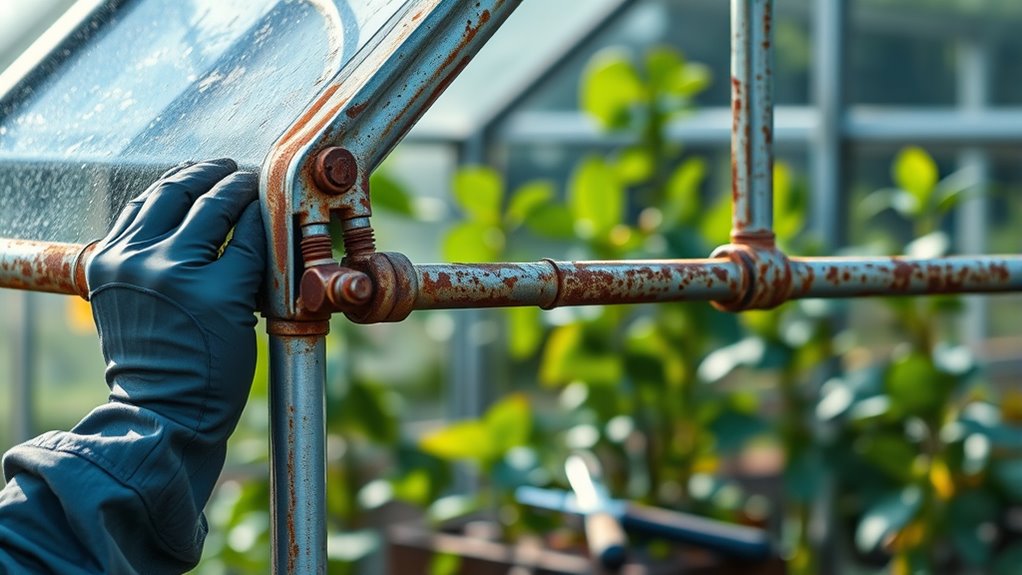
Inspecting your greenhouse frame regularly is crucial for maintaining its integrity and longevity.
Start by checking metal frames for rust or corrosion, especially at joints where damage often begins. If you have a wooden frame, look for signs of rot or decay, ensuring it remains structurally sound. Tighten any loose bolts or screws to prevent instability. Don't forget to inspect for physical damage like dents or cracks that could weaken the frame. Pay special attention to joints, as they're common points of failure. Additionally, conduct frequent inspections for pest infestations and weather-related damage. By conducting regular inspections and addressing issues promptly, you'll prolong your greenhouse's life and maintain a healthy growing environment.
Maintaining Glazing Materials
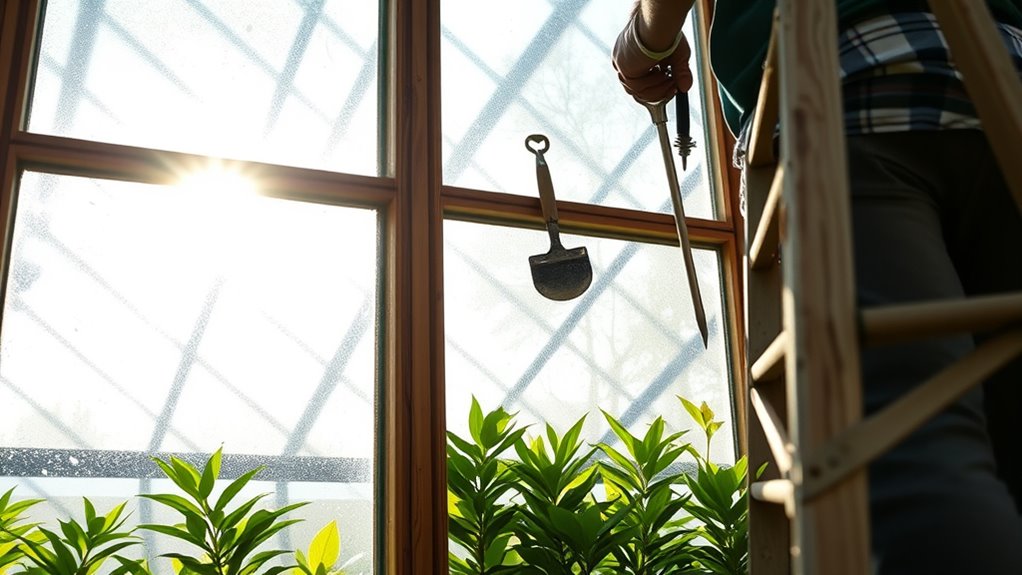
After ensuring your greenhouse frame is sound, it's time to focus on maintaining the glazing materials that protect your plants.
Different materials like glass, polycarbonate, and polyethylene each need specific care. Regularly inspect your glazing for cracks, discoloration, or gaps, as these can compromise structural integrity and allow pests in. Additionally, scheduling proactive inspections at least twice a year can help you address vulnerabilities before extreme weather conditions.
Clean the surfaces with mild detergents to enhance light transmission and prevent dirt buildup. Repair or replace any damaged panels promptly, opting for UV-resistant options to ensure longevity.
Don't forget to check seals and fasteners, applying weatherproof sealants where necessary to keep everything airtight. Scheduling these maintenance tasks at least twice a year will help you catch potential issues before they escalate.
Gutter and Drainage Care

To keep your greenhouse in top shape, it's crucial to prioritize gutter and drainage care. Regularly clean your gutters at least twice a year, especially after leaves have fallen. Use wooden or plastic scrapers to remove debris without causing damage.
Also, inspect for deterioration or biological growth like moss, which can lead to corrosion. Ensure your downspouts have wire strainers to block large debris and check for proper slope toward them. After severe weather, inspect for any damage.
Consider installing gutter guards to minimize maintenance and improve water flow. If you haven't yet, retrofitting your greenhouse with hanging gutters can enhance drainage and accessibility, making your maintenance routine more efficient. Additionally, staying informed about model performance evaluation can help you assess and improve your greenhouse's water management system.
Foundation and Support Checks
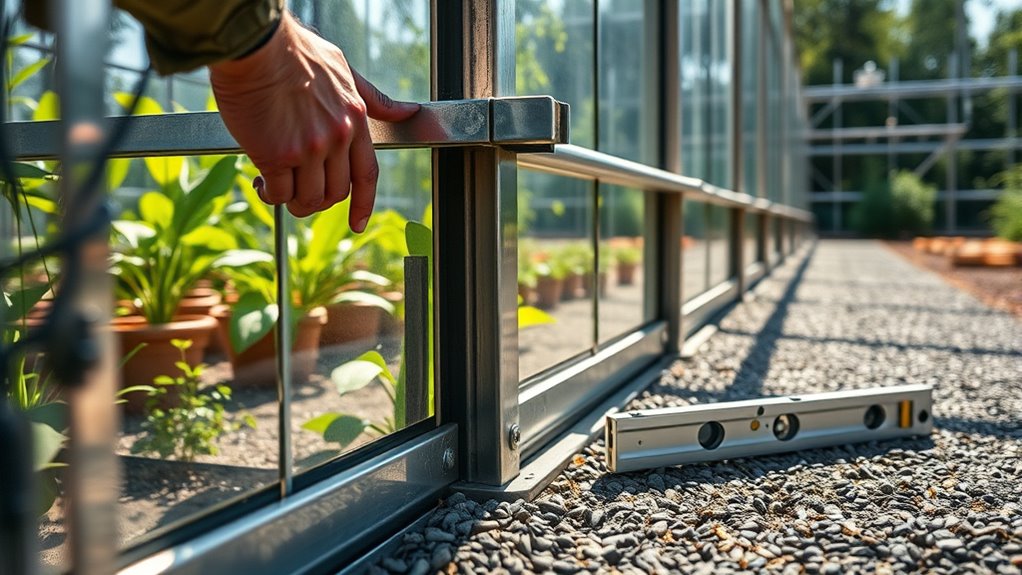
Maintaining the integrity of your greenhouse goes beyond just gutter and drainage care; it extends to the foundation and support structures that hold everything together.
Start by inspecting your foundation materials—whether concrete, wood, or masonry—for signs of wear or damage. Ensure your foundation's thickness is adequate, especially around the perimeter, and check for proper drainage to avoid water accumulation. Regularly assess the frame for corrosion or deterioration, paying close attention to joints and connections. Apply protective coatings to metal and sealants to wooden components to enhance longevity. Furthermore, it's crucial to inspect low areas and corners for mold or rot on wood frames to ensure the overall stability of the structure. Don't forget to repair any cracks promptly and remove weeds that can compromise the foundation. Schedule routine inspections to catch potential issues early, keeping your greenhouse sturdy and secure.
Door and Ventilation Upkeep
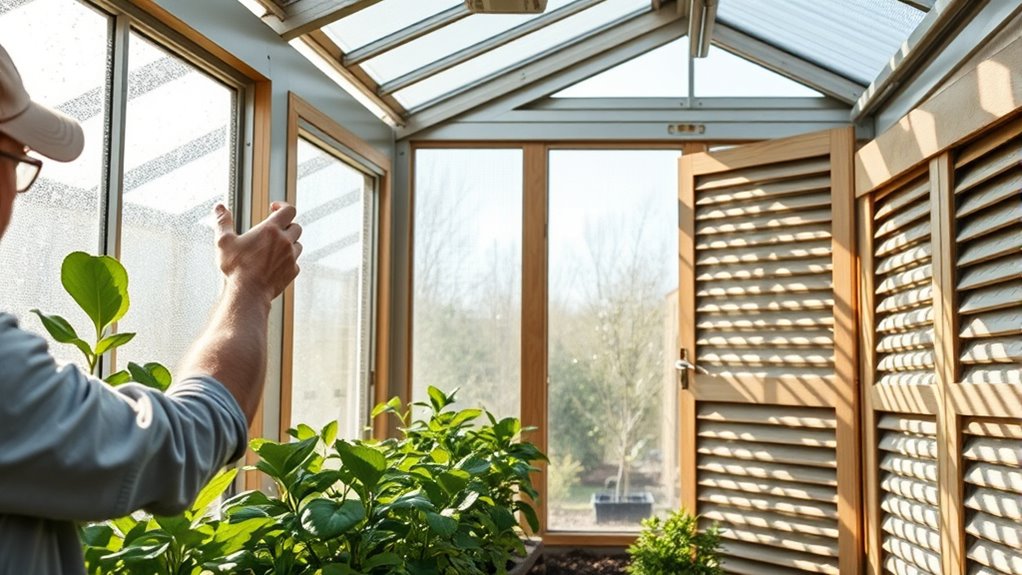
While ensuring your greenhouse remains functional, don't overlook the importance of door and ventilation upkeep. Regularly inspect door frames for wear or rot, especially around hinges and latches. Address gaps with foam seal strips to maintain a tight seal, and ensure all hardware is secure.
For ventilation, check that roof windows operate smoothly and seal any leaks. Clean or replace screens to keep insects out and ensure airflow. Make alignment adjustments to doors and windows to prevent gaps, and weatherproof them to keep moisture out. Wooden greenhouses often require more maintenance, so it's crucial to stay on top of repairs to prevent further deterioration.
Use durable materials for repairs and consider sustainability. By conducting routine inspections and establishing a cleaning schedule, you'll prevent minor issues from becoming major headaches.
Environmental Control Systems Calibration
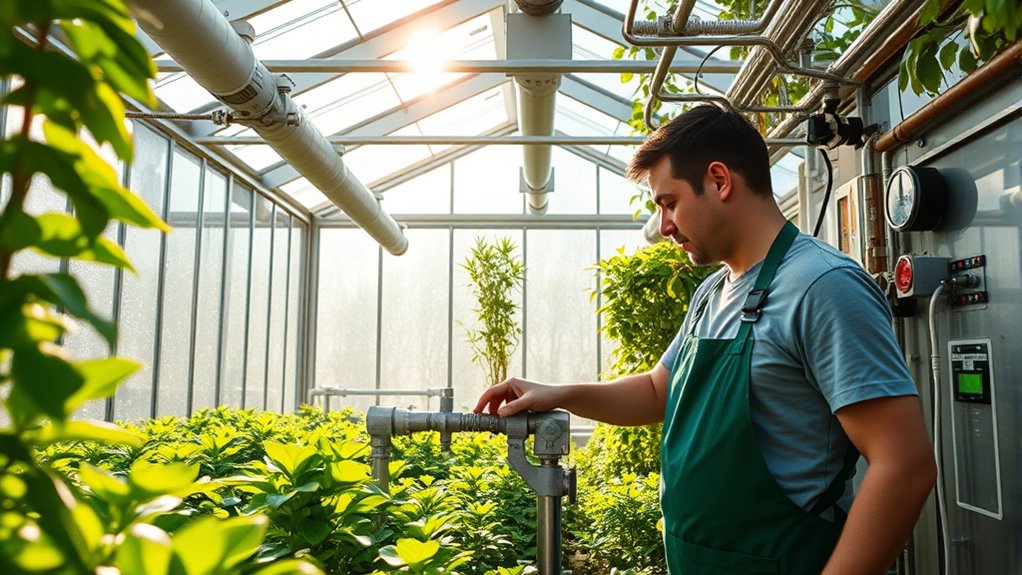
As you strive for optimal greenhouse conditions, calibrating your environmental control systems is essential. Start by ensuring your sensors for temperature and humidity are accurate; they're critical for effective climate control. Additionally, accurate control of greenhouse environment is vital for optimal crop production and should be a priority in your calibration process.
Regularly collect input and output data to estimate system parameters, ensuring that your model aligns with actual conditions. This good agreement between measured and computed values will enhance control precision.
Continuous real-time monitoring allows you to tweak parameters as needed, keeping your environment stable. Utilize your system's software for centralized management, which can automate adjustments based on external conditions.
Keeping Maintenance Logs
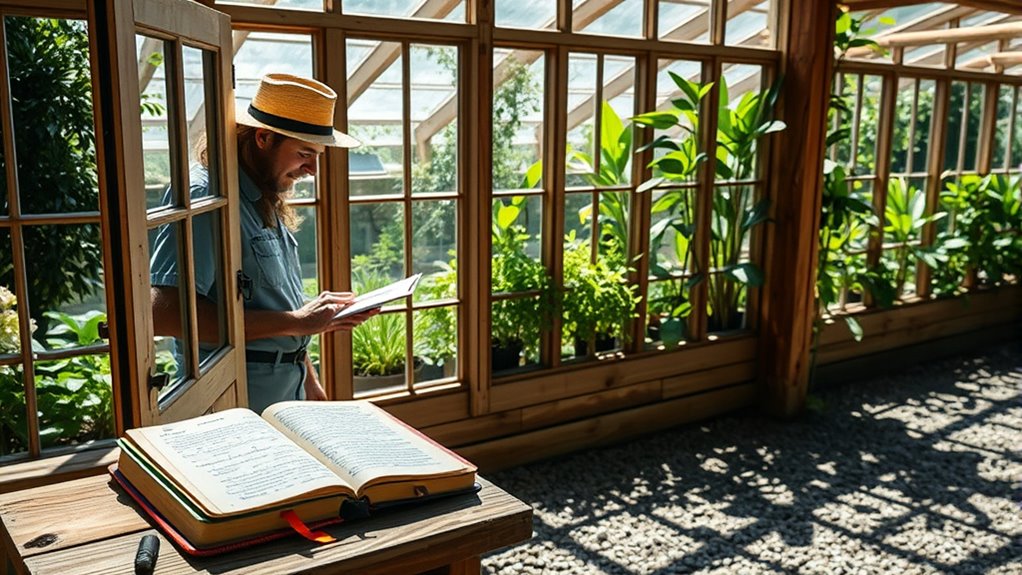
Calibrating your environmental control systems sets the foundation for a thriving greenhouse, but keeping maintenance logs takes your operations to the next level. These records help you collect vital data on temperature, lighting, and weather conditions, crucial for plant growth. By tracking plant performance, you can identify optimal conditions for each species. Maintenance logs also enhance resource management, allowing you to spot inefficiencies and reduce waste. Regularly recording temperature, lighting, and soil conditions supports informed decision-making and can lead to cost savings. Additionally, proper maintenance ensures that your greenhouse equipment operates efficiently, ultimately benefiting your overall productivity. Use tools like notebooks or digital spreadsheets for easy data entry and analysis. Consistency, accessibility, and regular reviews of your logs ensure you maintain a safe and efficient greenhouse environment, ultimately contributing to your success.
Frequently Asked Questions
How Often Should I Perform Greenhouse Maintenance?
You should perform greenhouse maintenance regularly, ideally at least once a month. This keeps your structure in top shape and helps prevent issues before they arise.
Don't forget to inspect different components like glazing, ventilation, and heating systems seasonally, as their requirements can change with the weather.
You'll also want to address any cleaning or repairs promptly to ensure a healthy environment for your plants. Regular checks make all the difference!
What Tools Are Essential for Greenhouse Maintenance?
For effective greenhouse maintenance, you'll need several essential tools.
Start with trowels and hand forks for soil work, pruning shears for plant care, and gloves to protect your hands.
Long-handled tools like rakes and shovels help with larger tasks, while hoses with spray nozzles make watering easier.
Don't forget thermometers and hygrometers for monitoring climate conditions.
Keeping these tools handy ensures your greenhouse remains healthy and productive.
Can I Do Maintenance During Winter?
Absolutely, you can do maintenance during winter!
For instance, imagine you're checking your greenhouse for cracks after a heavy snowfall. Winter is a great time to inspect, clean, and prepare for the upcoming growing season.
You'll want to ensure your heating systems are functioning and that you've insulated properly.
Taking these steps now will help protect your plants and set you up for success when spring arrives.
Don't overlook this crucial time!
What Are Signs of Structural Failure in Greenhouses?
You'll notice signs of structural failure in greenhouses such as rust and corrosion on metal components, cracked beams or panels, and a sagging foundation.
Broken frames and compromised glazing can also indicate serious issues.
Additionally, if you spot wind damage, weak frames, or poor anchoring, these could lead to collapse.
Pay attention to water damage and soil erosion around the foundation, as they can further compromise stability.
How Can I Improve Greenhouse Energy Efficiency?
To improve greenhouse energy efficiency, start by insulating walls and the perimeter to minimize heat loss.
Seal any gaps or cracks to enhance temperature control.
Upgrade to high-efficiency fans for better ventilation while saving energy.
Switch to LED lighting and use diffusers to maximize light efficiency.
Consider installing thermal screens and utilizing renewable energy sources, like solar, to further reduce reliance on nonrenewable energy.
Regularly monitor systems for optimal performance and resource allocation.
Conclusion
By regularly inspecting the greenhouse frame, maintaining glazing materials, and caring for gutters and drainage, you ensure a thriving environment for your plants. By checking foundations and supports, upkeeping doors and ventilation, and calibrating environmental control systems, you optimize growth potential. Finally, by keeping maintenance logs, you track progress and spot issues early. Embrace these practices, and your greenhouse will flourish, your plants will thrive, and your gardening experience will be rewarding.






